Dear Aspirants, Our IBPS Guide team is providing new series of Reasoning Questions for SBI PO 2019 so the aspirants can practice it on a daily basis. These questions are framed by our skilled experts after understanding your needs thoroughly. Aspirants can practice these new series questions daily to familiarize with the exact exam pattern and make your preparation effective.
[WpProQuiz 6609]
Click Here to Take Free Mock Test For SBI PO Mains
(Directions 1-5) Study the information given below and answer the questions carefully.
Eight employees – G, E, V, S, K, D, M and H of a firm are sitting in their respective cabin. The cabin is arranged in two parallel rows- R1 and R2, in such a way that R1 faces south and R2 faces north. An equal number of employees sit in two rows facing each other. Each belongs to different department viz. Quants, Reasoning, English and CA but not necessarily in same order. Not more than two belongs to the same department. Among them, the number of female employees is two less than the male employees.
S sits second to the right of H. The S and the one who faces H belongs to the same department. S faces a female employee who belongs to neither English nor Quants department. K sits at the extreme end of the row and faces the employee of the same department but not CA. Only one person sits between M and D. The employee sitting at the immediate right of D belongs to the same department as D. No other male employee sits at the extreme end of the row other than the employee belonging to English department. E and V don’t sit in the same row. Either K or S belongs to English Department. M is not an immediate neighbour of S or H. E belongs to reasoning department and is an immediate neighbour of the employee who belongs to English department. The employees belonging to CA department doesn’t face north. G faces the employee from reasoning department. V is an immediate neighbour of the employee from English department.
1) Who sits second to the right of E?
a) G
b) K
c) H
d) S
e) D
2) Who among the following does G faces?
a) V
b) H
c) E
d) D
e) S
3) Who among the following belongs to English department?
a) G
b) H
c) K
d) S
e) H
4) Which of the following statement is true?
a) D belongs to Reasoning department
b) K is a male employee
c) M and D are immediate neighbours of V
d) H faces M who is a male employee
e) None are true.
5) If H is related to Quants and S is related to reasoning in a certain way, then to which of the following department is M related to?
a) Reasoning department
b) Quants department
c) CA department
d) English department
e) Cannot be determined
Directions (6-10): Study the following information carefully and answer the questions given below.
Ten persons A, C, E, G, I, K, M, O, Q, and S are sitting around a circular table. All of them are not facing inside. All of them sit within an equal distance. Each one of them has a different number of chocolates i.e. 12, 14, 16, 18, 22, 24, 26, 28, 32, and 34 but not necessarily in the same order.
Only one person sits between E and I, who have 34 chocolates. The one, who have 12 chocolates, sits fourth to the right of A. S sits two places away from G, who have 14 Chocolates. K is an immediate neighbour of neither S nor G. O sits third to the left of Q, who has 28 chocolates. Only two persons sit between the one who has 12 chocolates and E. A is an immediate neighbour of Q. M has twice the chocolate of K. Q is not an immediate neighbour of M. K sits a fourth to the left of M. S is not an immediate neighbour of A. S have more chocolates than O. The one, who have 22 chocolates, sits third to the right of the one who have 26 chocolates. The difference between the chocolates for S and O is 6.
6) Who sits opposite to the one who have 12 chocolates?
a) A
b) Q
c) E
d) O
e) None of these
7) What is the position of M with respect to the one who have 16 chocolates?
a) Fourth to the left
b) Third to the left
c) Fourth to the right
d) Third to the right
e) None of these
8) How many persons sit between I and the one who have 22 chocolates?
a) One
b) Two
c) Three
d) Four
e) None of these
9) Who are the immediate neighbours of C?
a) S, the one who have 18 chocolates
b) I, the one who have 32 chocolates
c) O, the one who have 32 chocolates
d) The one who have 34 chocolates, M
e) None of these
10) If G related to 34, S related to 26 in the same way how many chocolates are O related to?
a) 22
b) 24
c) 26
d) 28
e) None of these
Answers :
(Directions 1-5) :

Among them, the number of female employees is two less than the male employees.
(From the above statement we can conclude that there is 3 female employees and 5 male employees.)
No other male employee sits at the extreme end of the row other than the employee belonging to English department. S sits second to the right of H. The S and the one who faces H belongs to the same department. S faces a female employee who belongs to neither English nor Quants department.
(From the above statements we can conclude that S sits at one of the extreme ends. Also that, all the female employees sits at the extreme ends.)
(We get two possibilities based on the position of S and H – Case (1) and Case (2) respectively.)
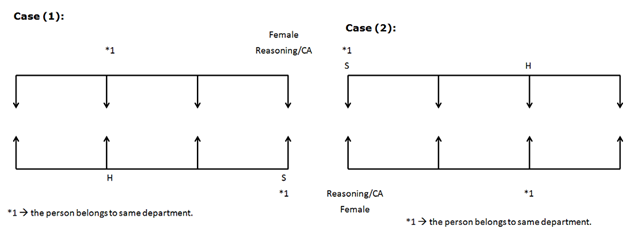
K sits at the extreme end of the row and faces the employee of the same department but not CA.
(Here we get further two possibilities based on the position of K.)
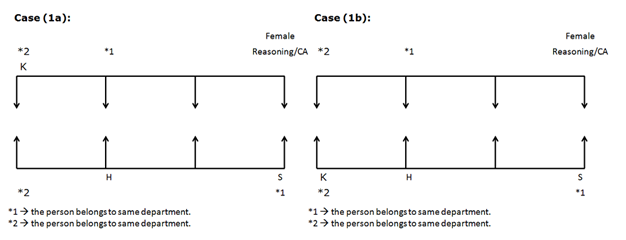
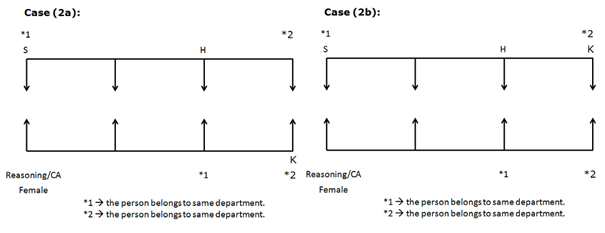
Only one person sits between M and D. The employee sitting at the immediate right of D belongs to the same department as D. M is not an immediate neighbour of S or H. The employees belonging to CA department doesn’t face north. E belongs to reasoning department and is an immediate neighbour of the employee who belongs to English department. V is an immediate neighbour of the employee from English department. E and V don’t sit in the same row.
(Since, M & D is not a neighbour of S and H; M and D sit in the other row. Since, the employee sitting in immediate right of D belongs to same department as D; we can conclude that D sits at the extreme ends in all the four possibilities.)
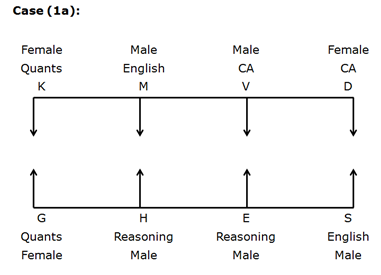
(From the above statements, we can conclude that D sits opposite to S and since the employees from CA doesn’t face north; we can conclude that D belongs to CA department. We can fix E and V near English department Employee. Also we can conclude that K and the person sitting opposite to her belong to Quants department.)

(From the above statements, we can conclude that D sits opposite to S and since the employees from CA doesn’t face north; we can conclude that D belongs to CA department. We can fix E and V near English department Employee. Also we can conclude that K and the person sitting opposite to her belong to Quants department. We get two possibilities based on the position of E and V.)

(From the above statements, we can conclude that D sits opposite to S and since the employees from CA doesn’t face north; we can conclude that D belongs to CA department. We can fix E and V near English department Employee. Also we can conclude that K and the person sitting opposite to her belong to Reasoning department. Since K and the person sitting opposite to her belongs to same department.)

(From the above statements, we can conclude that D sits opposite to S and since the employees from CA doesn’t face north; we can conclude that D belongs to Reasoning department. We can fix E and V near English department Employee. Also we can conclude that K and the person sitting opposite to her belong to Quants department.)
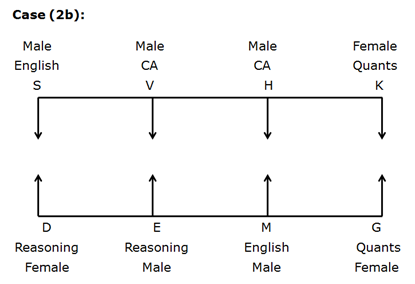
(From the above statements, we can conclude that D sits opposite to S and since the employees from CA doesn’t face north; we can conclude that D belongs to Reasoning department. We can fix E and V near English department Employee. Also we can conclude that K and the person sitting opposite to her belong to Quants department.)
G faces the employee from reasoning department.
(From the above statement, Case 1a, Case 1b-1, Case 2a and Case 2b gets eliminated.)
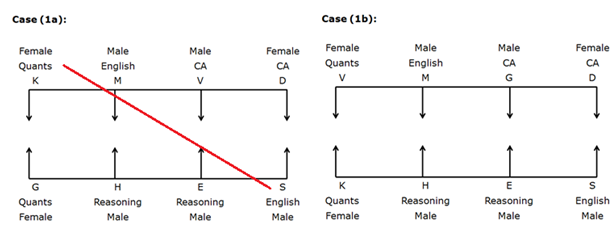


1) Answer: b)
2) Answer: c)
3) Answer: d)
4) Answer: d)
5) Answer: c)
Direction(6-10)

The one, who have 12 chocolates, sits fourth to the right of A. Only two persons sit between the one who have 12 chocolates and E.

Only one person sits between E and I, who have 34 chocolates.

O sits third to the left of Q, who has 28 chocolates. A is an immediate neighbour of Q.

In case 1b,A is an immediate neighbour of Q, this condition is not satisfied so rejected.
K sits a fourth to the left of M. Q is not an immediate neighbour of M. S sits two places away from G, who have 14 Chocolates. K is an immediate neighbour of neither S nor G. S is not an immediate neighbour of A.

In case 1a and case 2b, K is an immediate neighbour of neither S nor G, this condition is not satisfied, and so both cases are rejected.
M have twice the chocolate of K. S have more chocolates than O. The one, who have 22 chocolates, sits third to the right of the one who have 26 chocolates. The difference between the chocolates of S and O is 6.

Incase 2a (i), S have more chocolates than O, this condition is not satisfied so rejected.
So the final solution is case 2 a (ii).
6) Answer: b)
7) Answer: c)
8) Answer: d)
9) Answer: e)
10) Answer: a)





